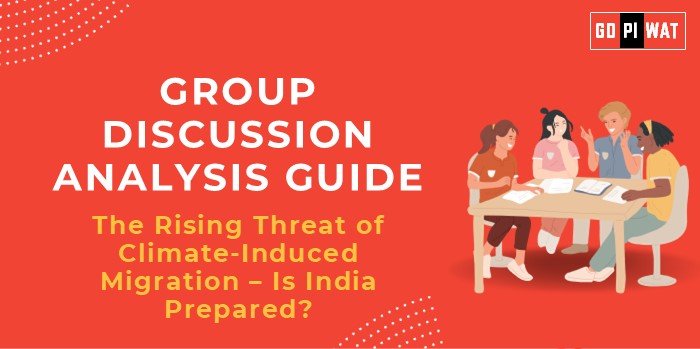📋 Group Discussion Analysis Guide
🌍 Topic: The Rising Threat of Climate-Induced Migration – Is India Prepared?
🌐 Introduction
Climate change is no longer a distant threat but a present reality reshaping the world. Its most significant human impact lies in climate-induced migration, a growing concern for India with its diverse population and geography. The question of whether India is prepared to manage this challenge goes beyond policy and infrastructure—it’s a test of resilience and foresight.
📊 Quick Facts & Key Statistics
- 🌎 Climate Migrants Worldwide: An annual average of 21.5 million people were displaced by weather-related events from 2008 to 2016. In 2022, this number surged to a record 32.6 million (UNHCR).
- 🌊 India’s Coastal Population: Approximately 364 million lived along India’s coast in 2020, projected to grow to 411 million by 2035—a 13% increase over 15 years (Census Data).
- 🌀 Cyclones in 2023: Cyclone Biparjoy caused severe damage in Gujarat, displacing thousands, highlighting the increasing frequency and intensity of such events.
- 🏙️ Urban Migration Surge: One-third of India’s population resided in urban areas in 2023, with projections indicating over 40% by 2030, partly driven by climate-related migration (NITI Aayog).
🤝 Stakeholders and Their Roles
- 🏛️ Government: Develops policies for disaster response, rehabilitation, and urban planning.
- 🏢 Urban Local Bodies: Manage migration inflows and infrastructure development.
- 🌍 NGOs: Support rehabilitation and provide aid to affected populations.
- 📋 Global Organizations: Offer policy guidance and financial support (e.g., UNHCR, World Bank).
🏆 Achievements and Challenges
🎯 Achievements
- 🌳 NAPCC Programs: Foster climate resilience through renewable energy and afforestation.
- 🌀 Cyclone Warning Systems: Timely alerts (e.g., for Cyclone Biparjoy) have saved thousands of lives.
- 🏠 Disaster-Resilient Housing: Odisha’s programs are a model of proactive adaptation.
⚠️ Challenges
- 🌊 Rising Coastal Population: Increased vulnerability to sea-level rise and storms.
- 🏙️ Urban Overpopulation: Unplanned migration overstresses city infrastructure.
- 📉 Lack of Comprehensive Migration Data: Hinders effective planning.
🌍 Global Comparisons
- 🇧🇩 Bangladesh: Resettlement initiatives for displaced communities.
- 🇳🇱 Netherlands: Advanced flood prevention through infrastructure investments.
📚 Case Studies
- 🌴 Sundarbans Region: Displacement of over 13,000 annually due to coastal erosion.
- 💧 Chennai Floods (2021): Demonstrated the cascading impacts of urban flooding.
💡 Effective Discussion Approaches
🌟 Opening Approaches
- 📊 “In 2022, 32.6 million people globally were displaced due to climate-related disasters, with India at the forefront of this crisis.”
- 🌴 “The Sundarbans’ rising displacement numbers exemplify the direct link between climate change and migration.”
🎯 Counter-Argument Handling
- 🤝 Acknowledge: “While India’s disaster response has improved, gaps remain in rehabilitation.”
- 💡 Propose: “Strengthening public-private partnerships could address infrastructure deficits.”
📊 Strategic Analysis of Strengths & Weaknesses
- 💪 Strengths: Strong disaster warning systems, progressive state-level initiatives (e.g., Odisha).
- 📉 Weaknesses: Urban infrastructure lagging behind migration rates.
- 🌟 Opportunities: Leverage international aid for resettlement and infrastructure development.
- ⚠️ Threats: Increasing climate events could overwhelm existing systems.
🗣️ Structured Arguments for Discussion
- ✅ Supporting Stance: “India’s disaster management frameworks have saved lives and showcased resilience.”
- ❌ Opposing Stance: “Urban areas remain underprepared for migration inflows driven by climate events.”
- ⚖️ Balanced Perspective: “India is taking strides in disaster response, but integrating climate migration into urban planning is essential.”
📚 Connecting with B-School Applications
- 📈 Real-World Applications: Urban planning projects focusing on sustainable migration management.
- 📋 Sample Interview Questions:
- 🤔 “How should India balance urbanization and climate resilience?”
- 🌍 “Can India replicate successful global models for managing climate displacement?”
- 💡 Insights for Students: Opportunities to analyze urban migration patterns and propose data-driven solutions for sustainable urban growth.


